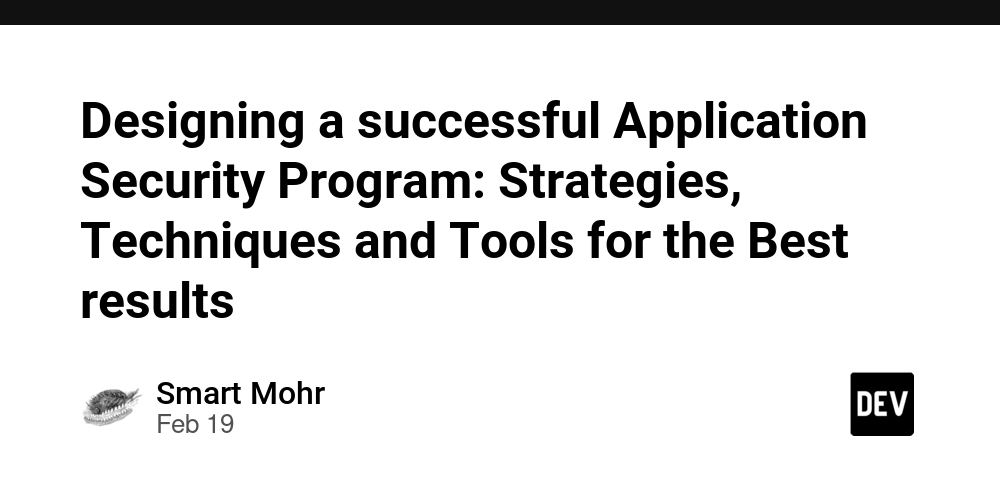Designing a successful Application Security Program: Strategies, Techniques and Tools for the Best results
The complexity of modern software development requires a comprehensive, multifaceted approach to security of applications (AppSec) which goes far beyond just vulnerability scanning and remediation. ai in appsec The constantly changing threat landscape coupled with the rapid pace of technology advancements and the increasing intricacy of software architectures, requires a comprehensive, proactive strategy that seamlessly integrates security into all phases of the development process. agentic ai in appsec This comprehensive guide outlines the fundamental components, best practices and cutting-edge technology used to build a highly-effective AppSec program. It empowers companies to increase the security of their software assets, reduce the risk of attacks and create a security-first culture. security assessment tools At the center of the success of an AppSec program is a fundamental shift in thinking that sees security as an integral aspect of the development process rather than a secondary or separate undertaking. This paradigm shift requires an intensive collaboration between security teams operators, developers, and personnel, removing silos and creating a belief in the security of the software they develop, deploy and manage. DevSecOps lets organizations integrate security into their development processes. This means that security is taken care of in all phases of development, from concept, design, and deployment all the way to the ongoing maintenance. The key to this approach is the development of clear security guidelines, standards, and guidelines which establish a foundation for safe coding practices, threat modeling, and vulnerability management. These guidelines should be based upon industry best practices, including the OWASP Top Ten, NIST guidelines as well as the CWE (Common Weakness Enumeration) and take into account the particular needs and risk profiles of the specific application and business environment. These policies should be codified and made accessible to everyone in order for organizations to have a uniform, standardized security approach across their entire application portfolio. AI AppSec It is vital to fund security training and education programs to aid in the implementation of these policies. These programs must equip developers with the knowledge and expertise to write secure code, identify potential weaknesses, and follow best practices for security throughout the process of development. secure coding assistant The training should cover a variety of areas, including secure programming and the most common attack vectors as well as threat modeling and secure architectural design principles. The best organizations can lay a strong foundation for AppSec by fostering an environment that encourages constant learning, and giving developers the tools and resources they require to integrate security in their work. Organizations should implement security testing and verification processes along with training to detect and correct vulnerabilities prior to exploiting them. This requires a multilayered approach, which includes static and dynamic analysis methods and manual code reviews as well as penetration testing. Static Application Security Testing (SAST) tools can be used to study source code and identify possible vulnerabilities, like SQL injection cross-site scripting (XSS), and buffer overflows early in the process of development. Dynamic Application Security Testing (DAST) tools on the other hand can be utilized to simulate attacks on running applications, identifying vulnerabilities which aren't detectable by static analysis alone. These automated testing tools can be extremely helpful in finding weaknesses, but they're far from being a solution. manual penetration testing performed by security experts is also crucial to uncovering complex business logic-related weaknesses that automated tools may not be able to detect. By combining automated testing with manual validation, organizations can achieve a more comprehensive view of their overall security position and prioritize remediation efforts based on the potential severity and impact of vulnerabilities that are identified. Enterprises must make use of modern technology, like machine learning and artificial intelligence to enhance their capabilities in security testing and vulnerability assessments. AI-powered tools are able to analyse large quantities of data from applications and code and spot patterns and anomalies that may signal security concerns. These tools also learn from past vulnerabilities and attack patterns, continuously improving their abilities to identify and stop new threats. A particularly exciting application of AI within AppSec is using code property graphs (CPGs) to enable greater accuracy and efficiency in vulnerability detection and remediation. CPGs offer a rich, semantic representation of an application's codebase. They capture not only the syntactic structure of the code, but as well as the c

The complexity of modern software development requires a comprehensive, multifaceted approach to security of applications (AppSec) which goes far beyond just vulnerability scanning and remediation. ai in appsec The constantly changing threat landscape coupled with the rapid pace of technology advancements and the increasing intricacy of software architectures, requires a comprehensive, proactive strategy that seamlessly integrates security into all phases of the development process. agentic ai in appsec This comprehensive guide outlines the fundamental components, best practices and cutting-edge technology used to build a highly-effective AppSec program. It empowers companies to increase the security of their software assets, reduce the risk of attacks and create a security-first culture.
security assessment tools At the center of the success of an AppSec program is a fundamental shift in thinking that sees security as an integral aspect of the development process rather than a secondary or separate undertaking. This paradigm shift requires an intensive collaboration between security teams operators, developers, and personnel, removing silos and creating a belief in the security of the software they develop, deploy and manage. DevSecOps lets organizations integrate security into their development processes. This means that security is taken care of in all phases of development, from concept, design, and deployment all the way to the ongoing maintenance.
The key to this approach is the development of clear security guidelines, standards, and guidelines which establish a foundation for safe coding practices, threat modeling, and vulnerability management. These guidelines should be based upon industry best practices, including the OWASP Top Ten, NIST guidelines as well as the CWE (Common Weakness Enumeration) and take into account the particular needs and risk profiles of the specific application and business environment. These policies should be codified and made accessible to everyone in order for organizations to have a uniform, standardized security approach across their entire application portfolio.
AI AppSec It is vital to fund security training and education programs to aid in the implementation of these policies. These programs must equip developers with the knowledge and expertise to write secure code, identify potential weaknesses, and follow best practices for security throughout the process of development. secure coding assistant The training should cover a variety of areas, including secure programming and the most common attack vectors as well as threat modeling and secure architectural design principles. The best organizations can lay a strong foundation for AppSec by fostering an environment that encourages constant learning, and giving developers the tools and resources they require to integrate security in their work.
Organizations should implement security testing and verification processes along with training to detect and correct vulnerabilities prior to exploiting them. This requires a multilayered approach, which includes static and dynamic analysis methods and manual code reviews as well as penetration testing. Static Application Security Testing (SAST) tools can be used to study source code and identify possible vulnerabilities, like SQL injection cross-site scripting (XSS), and buffer overflows early in the process of development. Dynamic Application Security Testing (DAST) tools on the other hand can be utilized to simulate attacks on running applications, identifying vulnerabilities which aren't detectable by static analysis alone.
These automated testing tools can be extremely helpful in finding weaknesses, but they're far from being a solution. manual penetration testing performed by security experts is also crucial to uncovering complex business logic-related weaknesses that automated tools may not be able to detect. By combining automated testing with manual validation, organizations can achieve a more comprehensive view of their overall security position and prioritize remediation efforts based on the potential severity and impact of vulnerabilities that are identified.
Enterprises must make use of modern technology, like machine learning and artificial intelligence to enhance their capabilities in security testing and vulnerability assessments. AI-powered tools are able to analyse large quantities of data from applications and code and spot patterns and anomalies that may signal security concerns. These tools also learn from past vulnerabilities and attack patterns, continuously improving their abilities to identify and stop new threats.
A particularly exciting application of AI within AppSec is using code property graphs (CPGs) to enable greater accuracy and efficiency in vulnerability detection and remediation. CPGs offer a rich, semantic representation of an application's codebase. They capture not only the syntactic structure of the code, but as well as the complicated connections and dependencies among different components. By harnessing the power of CPGs artificial intelligence-powered tools, they are able to perform deep, context-aware analysis of an application's security position and identify vulnerabilities that could be overlooked by static analysis methods.
CPGs can be used to automate the remediation of vulnerabilities employing AI-powered methods for repair and transformation of the code. Through understanding the semantic structure of the code and the characteristics of the vulnerabilities, AI algorithms can generate targeted, context-specific fixes that solve the root cause of the issue rather than merely treating the symptoms. This technique does not just speed up the remediation but also reduces any risk of breaking functionality or introducing new security vulnerabilities.
Integration of security testing and validation in the continuous integration/continuous deployment (CI/CD) pipeline is another key element of an effective AppSec. Automating security checks, and integration into the build-and deployment process allows companies to identify vulnerabilities early on and prevent them from affecting production environments. This shift-left approach to security enables more efficient feedback loops, which reduces the time and effort required to identify and remediate issues.
To reach this level of integration companies must invest in the right tooling and infrastructure to support their AppSec program. This goes beyond the security testing tools themselves but also the underlying platforms and frameworks that enable seamless integration and automation. Containerization technologies like Docker and Kubernetes play a crucial role in this regard, because they provide a repeatable and constant setting for testing security as well as separating vulnerable components.
Effective collaboration tools and communication are just as important as technical tooling for creating a culture of safety and enable teams to work effectively together. Issue tracking tools such as Jira or GitLab can assist teams to prioritize and manage weaknesses, while chat and messaging tools such as Slack or Microsoft Teams can facilitate real-time communication and sharing of knowledge between security specialists as well as development teams.
Ultimately, the performance of the success of an AppSec program depends not only on the tools and technology employed, but also the process and people that are behind the program. In order to create a culture of security, you require an unwavering commitment to leadership in clear communication as well as an effort to continuously improve. Through fostering a sense sharing responsibility, promoting dialogue and collaboration, and supplying the appropriate resources and support, organizations can establish a climate where security is more than a box to check, but an integral element of the development process.
To maintain the long-term effectiveness of their AppSec program, companies should also focus on establishing meaningful measures and key performance indicators (KPIs) to measure their progress and find areas for improvement. These metrics should be able to span the entire lifecycle of applications starting from the number of vulnerabilities discovered in the initial development phase to time taken to remediate problems and the overall security posture of production applications. These indicators can be used to demonstrate the benefits of AppSec investment, spot trends and patterns, and help organizations make decision-based decisions based on data on where to focus on their efforts.
To stay on top of the ever-changing threat landscape and new best practices, organizations must continue to pursue learning and education. It could involve attending industry events, taking part in online courses for training and collaborating with outside security experts and researchers to stay on top of the most recent developments and techniques. Through fostering a continuous education culture, organizations can make sure that their AppSec applications are able to adapt and remain robust to the latest threats and challenges.
It is vital to remember that application security is a continual process that requires constant investment and commitment. As new technology emerges and development methods evolve companies must constantly review and review their AppSec strategies to ensure they remain relevant and in line to their business objectives. If they adopt a stance of continuous improvement, fostering collaboration and communication, and using the power of modern technologies such as AI and CPGs, organizations can create a strong, flexible AppSec program that does not just protect their software assets but also helps them be able to innovate confidently in an increasingly complex and challenging digital landscape.
ai in appsec









































































































































































![[The AI Show Episode 142]: ChatGPT’s New Image Generator, Studio Ghibli Craze and Backlash, Gemini 2.5, OpenAI Academy, 4o Updates, Vibe Marketing & xAI Acquires X](https://www.marketingaiinstitute.com/hubfs/ep%20142%20cover.png)



























































































































![[FREE EBOOKS] The Kubernetes Bible, The Ultimate Linux Shell Scripting Guide & Four More Best Selling Titles](https://www.javacodegeeks.com/wp-content/uploads/2012/12/jcg-logo.jpg)



![From drop-out to software architect with Jason Lengstorf [Podcast #167]](https://cdn.hashnode.com/res/hashnode/image/upload/v1743796461357/f3d19cd7-e6f5-4d7c-8bfc-eb974bc8da68.png?#)






































































































.png?#)




.jpg?#)
































_Christophe_Coat_Alamy.jpg?#)








































































































![Rapidus in Talks With Apple as It Accelerates Toward 2nm Chip Production [Report]](https://www.iclarified.com/images/news/96937/96937/96937-640.jpg)








































































































































